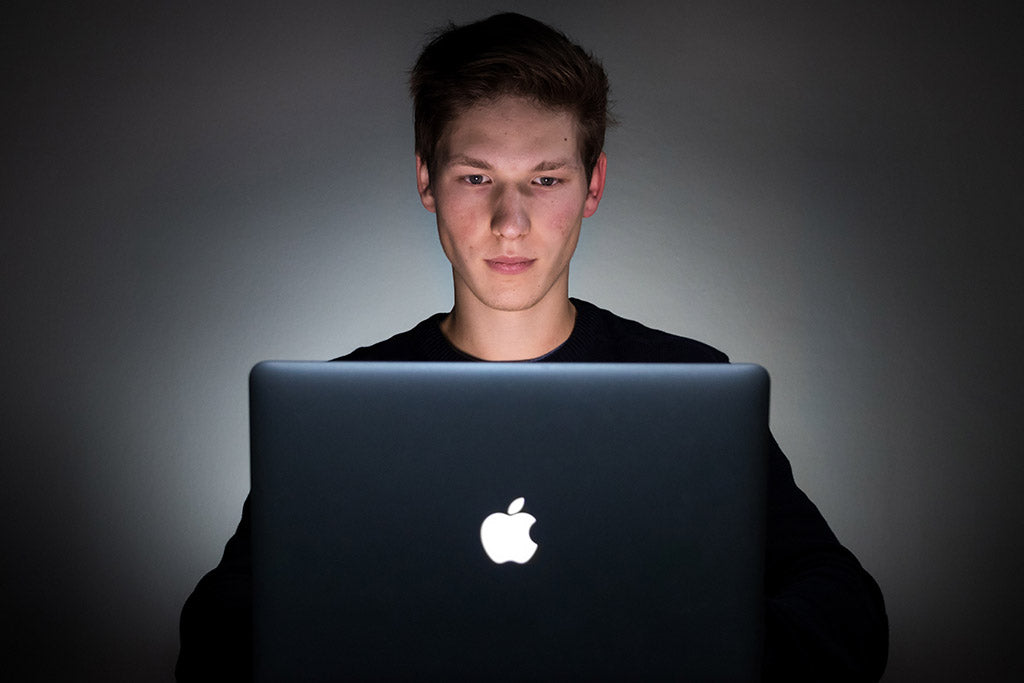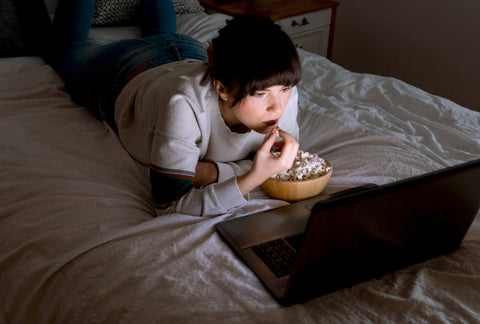If you can’t seem to tear yourself away from screens these days and have been suffering from eye strain or headaches from spending prolonged periods of time on all your gadgets, you’re not alone. Between streaming videos, writing emails and online banking, it’s hard to imagine life before smartphones.
The eye fatigue that ultimately ensues is called digital eye strain, and it affects 59% of Americans. It’s caused by the blue light emitted by the screens of desktop monitors, laptop computers, tablets, and smartphones.
More and more studies have been done on the health impact of blue light, and what scientists have found is alarming.
The Negative Health Effects of Blue Light
While blue light is part of the visible light spectrum (e.g., sunlight) and can help us stay alert, the use of modern technologies (e.g., screens and LED lights) is increasing the duration and proximity of our exposure, which is causing many undesirable health effects such as headaches, blurred vision, dry eyes, neck and shoulder pain, and difficulty falling asleep or staying asleep.
Blue light throws off our circadian rhythms. According to a Harvard study, prolonged exposure elevates blood sugar levels, suppresses melatonin secretion, increases stress, and could be associated with health conditions such as cancer, diabetes, heart disease, and obesity.
While it’s not possible to eliminate the use of screens from our daily life, we can minimize blue light exposure by using blue light blocking apps on computers, tablets, and smartphones.
Best Blue Light Filters for Laptops, Tablets, and Smartphones
Blue light filter applications reduce our exposure by decreasing the blue light brightness and intensity inside each pixel on an LCD screen. As a result, the screen will look warmer (or more “red”) when you’re using these blue light blocking apps.
Here are some of the most popular blue light filter apps, some of which are built-in features you can use on your iPad, iPhone, Android, PC, and Mac:
Built-In Blue Light Filter for Your Apple Devices
- Night Shift: This setting is built into iPhones running iOS 9.3 or later and newer versions of iPads. Activating Night Shift reduces the amount of blue light emitted from the screen. Schedule the app to turn on automatically every day at the same time (usually in the evening) – so you can “set it and forget it.” This way, at night when your eyes need a rest from blue light, your screen gets less bright automatically. This app comes with your iPhone or iPad and is easy to use, but it doesn’t offer much in the way of customization. Our advice would be to turn this on for sure, it’s a no-brainer.
Built-In Blue Light Filter for Your Android Devices
-
Night Mode: This feature is built into the newer versions of Andriod, such as Android Oreo and Android Pie. You can activate Night Mode in the settings and configure it to turn on and off automatically at a preset time. When it starts getting dark, your screen dims. Makes sense. Again, turn this on for sure, it’s the least you can do for your eye health.
- Twilight: This feature neutralizes blue light coming from an Android device's screen. You can customize your experience by choosing the color temperature, intensity, and brightness to correlate with sunrise and sunset, your alarm, or other custom settings. The app also offers information on the science of blue light and how it impacts your health. It has a user-friendly interface and is highly rated in the Google Play Store for free.
Blue Light Blocking Apps for Your PC
- Redshift: Available for Windows and Linux, this intuitive app adjusts the color temperature of the screen based on the position of the sun in your location. In the early morning, the color transitions from night to daytime temperature to help your eyes slowly adapt. In the evening, the color temperature is reduced to match that of indoor lighting. The app is a free open-source project created for Linux, so it cannot be optimized for other operating systems (e.g., Windows, MacOS).
- SunsetScreen: This app is similar to Redshift but offers the option to keep the screen brighter longer during winter months as some people benefit from blue light exposure in the late afternoon after the sun has gone down. This app allows you to customize sunrise and sunset times as well as selecting a precise color for the screen. However, some users find the interface outdated and unappealing.
Best Blue Light Filter App for Your Mac & PC
-
f.lux: This app changes the color of the computer screen to adapt to the time of day, making it warm at night and mimicking sunlight during the day. You simply input the type of lighting and your location, then the app will adjust the screen automatically. This app is free for personal use on MacOS and also available for Windows and Linux.
- Iris: This app detects whether it's daytime or nighttime and adjusts the amount of blue light emitted by the screen accordingly. There are many presets and customizable options, such as color temperature, brightness, manual/automatic settings, and the type of activities (e.g., sleeping, reading, programming, biohacker, sunglasses, movie). The app is available for most major desktop and mobile platforms, including Windows, Android, Linux, and iOS. You can download a 7-day free trial or purchase it for a $15 one-time fee.
Ultimately Apps Don't Provide Adequate Protection
While blue light blocking apps mitigate the negative impacts of blue light exposure, they aren’t designed to solve all the issues associated with prolonged use of digital devices and computer screens.
For example, they can’t prevent eye problems associated with light exposure. Additionally, keep in mind that blue light exposure in the evening can come from other sources such as fluorescent light, city lights and TV screens; and other frequencies such as green light which is harmful as well in the evening. Today it’s becoming vital to be mindful about all the light sources and frequencies in your environment and their impact on your health and wellbeing.




